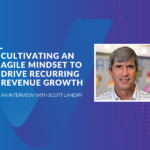Your Employee Experience Determines Your Business’ Success
The Employee Experience (EX) is the journey an employee takes with your organization and is the sum of all employee-employer interactions throughout that employee lifecycle, from pre-recruitment to post-exit. A recent Towers Watson study revealed that businesses with a strong employee experience sustained a 4% bump in revenue while those with a poor experience saw revenue fall by 1%. The impact on profit margins was also staggering: businesses with a strong experience saw 3% growth in one-year gross profit while companies with a weak employee experience endured a 10% drop (2019). Notably, organizations that deliver an extraordinary experience win with their employees and, in turn, experience exceptional business wins.
Ready to drive better business outcomes? In this article, we breakdown why improving your Employee Experience should be a strategic priority for your organization and 6 data-driven ways you can provide a winning employee experience that accelerates business success.
Exceptional EX Drives Exceptional CX
Investing in Employee Experience results in higher employee retention and increased performance. In fact, companies that prioritized Employee Experience achieved 1.8 times faster revenue growth (Salesforce, 2020). Fortunately, investing in your Employee Experience also has a far-reaching impact on your Customer Experience motion.
Customer Experience (CX) and Employee Experience are two sides of the same coin. While many recurring revenue organizations have focused on becoming customer-centric, many have missed the mark on being employee-centric. Employees matter as much to your business success as your customers, and a truly exceptional CX can only be driven by an exceptional EX. According to a recent study by IDC, 85% of business leaders agree that an improved employee experience and higher employee engagement result in a better customer experience, higher customer satisfaction, and higher revenues for their organization (2021). Happy employees create happy customers; you can’t have a customer-centric culture without first having an employee-centric culture. By putting your employees at the heart of your company, you will invariably accelerate customer-centricity and value-centricity.
Mapping Your Employee Experience Journey
Employee journey mapping is a crucial exercise for organizations that are either in the early stages of thinking about their Employee Experience, or are looking for new ways to improve their current Employee Experience strategy. Just like a customer journey mapping workshop, the employee journey map identifies the key milestones, such as onboarding and exit plans, and the most significant employee-employer interactions that shape employee perceptions. By identifying these critical stages, you can then employ best practices to improve and optimize employee acquisition, engagement and performance.
More important than the employee journey map, however, is the actual employee experience and the interactions they have at each stage of their lifecycle. One negative experience in one stage can have a domino effect and create problems throughout the entire employee lifecycle. As you undergo a journey mapping exercise and form an effective Employee Experience strategy, consider the following factors from the perspective of the employee:
- The quality of the relationship that the employee has with their manager and peers
- The clarity of the employee’s role within the organization
- The value the employee brings to the organization and your team
- The potential effects, both positive and negative, of the employee’s work on their overall wellbeing
6 Elements Of A Strong EX
1. Culture
82% of business leaders believe that culture is a competitive advantage (Deloitte, 2016). A strong Employee Experience begins with a clear understanding of your organization’s vision, mission, values and the culture that you want to create. To drive a truly unique and powerful EX, every part of the employee lifecycle should be mapped to your distinctive organizational identity.
Culture extends far beyond the words on your website; it must be reflected in your recruiting and onboarding processes, ongoing development and day-to-day interactions. The way in which your organization onboards a new hire, conducts employee performance reviews, or offboards a team member impacts the individual employee and showcases who you are and what you care about to the rest of the organization as well.
When determining how to incorporate your company’s values and purpose into your Employee Experience strategy, ask your colleagues the following questions:
- How is our company culture expressed in our onboarding and onboarding processes?
- How does our culture appear in an employee performance review and other day-to-day activities?
- How can we incorporate our culture into our interactions and processes?
2. Development Programs
41% of employees consider career development and personal growth opportunities important to their job satisfaction (SHRM, 2017). The more you invest in training people to perform and excel in their roles, the more willing people are to take the lead on new initiatives and challenges. To empower your employees to advance in their careers, we recommend offering a career development fund to champion continuous learning and creating an in-house mentorship program that partners employees with more experienced team members.
3. Feedback
The more employees are heard, the more valued and engaged they feel; employees who feel their voice is heard are 4.6 times more likely to feel empowered to perform their best work (Salesforce, 2017). Creating a constant feedback loop between employees and management transforms the employee experience and drives better business outcomes.
To gain a deeper understanding of how your employees feel and to measure their engagement, you should deploy different types of feedback mechanisms at regular intervals and key moments throughout the employee lifecycle. We recommend that you employ pulse surveys to regularly capture employee attitudes and ad-hoc surveys to collect feedback on time-sensitive issues, such as new organizational programs, policies or initiatives.
4. Diversity & Inclusion (D&I)
Creating an inclusive culture and a workplace where employees feel respected, valued and comfortable isn’t just good practice, it’s also essential to your company’s bottom line. A Harvard Business Review study found that companies with higher-than-average diversity had 19% higher innovation revenues (2018). When D&I is employed properly, it allows your organization to attract the most qualified employees and accelerate innovation through a diverse set of backgrounds and ideas. To put this into practice, clearly communicate your D&I initiatives to your employees and set tangible and achievable goals that hold your team and organization accountable.
5. Recognition
Companies that actively recognize and reward their employees are more likely to experience increased accountability, responsibility and engagement. Business leaders say that their employee recognition program helps with employee experience (89%), employee relationships (86%), organizational culture (85%), employee engagement (84%) and organizational values (83%) (WorkHuman, 2018). It’s important that your leadership team approaches employee recognition as not just a mere program, but as an organizational practice with real and measurable business impact. While salary and benefits are an important piece of employee recognition, this practice should extend beyond financial incentives. We recommend that you initiate regular shout-outs and kudos through public forums, like a company-wide communications channel, and conduct 1:1 meetings to regularly recognize and encourage your employees’ contributions.
6. Communication
Developing an effective employee communication strategy will allow you to break down barriers across the organization and create a connected ecosystem – an empowered and connected office environment can increase worker productivity by up to 25% (Journal of Experimental Psychology, 2017).
To ensure everyone in your organization is informed on and aligned to the company’s vision, you should create multiple methods and regular cadences of employee communication, such as company-wide newsletters and in-person (or virtual) town halls. Keep in mind that communication should be a two-way street so you should give your employees their own voice. We recommend creating a common platform for them to share their thoughts and ideas, such as a Slack channel, an anonymous message board or survey.
Lead A People-Powered Transformation
The impact and importance of employee experience cannot be overstated. A well-thought-out Employee Experience strategy that takes into consideration culture, feedback, recognition, communication, D&I and development is vital to championing greater levels of employee engagement, enthusiasm, involvement, and retention. By optimizing your Employee Experience, you’ll lead a happier team towards better business outcomes.
Is your current Employee Experience strategy actually driving value for your employees? Run your current Employee Experience initiatives through the 5 stages of the operational improvement cycle to discover potential growth areas.





